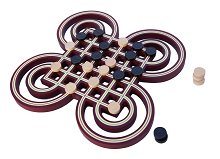The Rules of Fighting Serpents
The game of Fighting Serpents or Fighting Snakes is an ancient Mexican game played in a similar way to draughts. Variants exists and official rules are not known so the rules here are merely one possible way of playing.
See also: Ancient & Historical Board Games.
Equipment
The game of Fighting Serpents is played on a special board of 3 parallel horizontal lines intersected by a number of left and right leaning diagonals across the width of the board. At each ends a line curves round joining each corner point to the ends of the middle line. So there is one more intersection in the middle line than the top and bottom lines. The number of diagonal and thus intersecting points varies - perhaps 17 intersections across the middle line and 16 across the top and bottom lines is typical. Coloured pieces in 2 colours of any sort can be used. We'll refer to black and white pieces in the following text.
Preparation and Objective
Toss a coin to decide who plays first. Playing first is generally thought to be disadvantageous because of the lack of options. The player playing black pieces places them on all the points of the nearest row plus the rightmost points on the middle row as the player looks at it. The other player sets the white pieces up in exactly the same way. The middle point and the two points at either end of the middle row should be left without a piece upon them. The objective of the game is to take all of the opponent's pieces or to produce a position such that the opponent is unable to move.
Play
Players take turns to move one of their pieces. A piece may only move along the lines inscribed upon the board. For each turn a piece makes either a capturing move or an ordinary move. An ordinary move is made by simply moving a piece along a line to an adjacent point. Whenever a piece has an opponent's piece adjacent to it and the point immediately beyond the opponent's piece in a straight line is vacant, the opponent's piece can be captured. A piece is taken by simply hopping over it into the vacant point beyond and removing it from the board. Unlike an ordinary move, a capturing move can consist of several such hops - if a piece takes an opponent's piece and the new position allows it to take another piece, then it can do so straight away. In many diagrams, the board is shown with curved ends. It is assumed that this is done deliberately to indicate that it is possible to capture a piece at either end by jumping over it along the curved line.
Finishing
The game is won by the player who first manages to take all his opponent's pieces or by the player who has more pieces when it becomes apparent that no more pieces will be taken. Alternatively, a player can win by rendering the other player unable to move. A draw occurs by agreement at any point during the game. If it becomes apparent that no more pieces will be taken and both players have the same number of pieces left, a draw is agreed. Draws are common.
Variant
To make the game more interesting, participants might like to try the following additional rules proposed for Alquerque (which is played in almost exactly the same way) by R. C. Bell in his "Board and Table Games from Many Civilisations". Primarily this adapts the compulsory capture and the "forward only" rules from Draughts.
- If the player has the opportunity to capture one or more of the opponent's pieces, then the player must do so. If a piece takes an opponent's piece and the new position allows it to take another piece, then it must do so straight away.
- If a player notices that the opponent failed to capture when the option was open, that player can "huff" the offending piece before the next move is made, and it is removed from the board.
- If more than one piece can capture, then the player is entirely free to choose which of those pieces to move. Likewise, if a capturing piece is able to capture in more than one direction, the player is free to choose which direction to move in. i.e. it is not compulsory to move the piece or take the route that will result in the maximum number of captures.
- A piece cannot move backwards, only sideways, forwards or diagonally forwards. A piece that has reached the final row may only move by capturing sideways.
These rules are provided by Masters Traditional Games, an Internet shop selling quality traditional games, pub games and unusual games. For general information or for copying and copyright, see our Rules Information page.
Our rules are comprehensive instructions for friendly play. If in doubt, always abide by locally-played or house rules.
Copyright James Masters, 2024. All rights reserved.









































